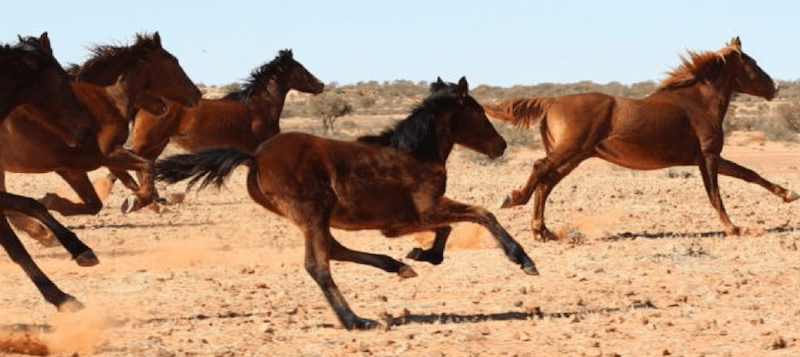Handy Hoof Hints, Part 4
By Carole Herder

The idea that working horses can be barefoot is not new. Horses have a long history of barefoot performance and have carried fully armored men into battle. They have been used for fieldwork, war, and performance in their natural barefoot state.
Horses’ hooves are a miraculous structure designed with innate intelligence to function as support for their weight in movement. In natural function, when a horse’s full weight descends, the hoof is sandwiched between that load and the ground. The hoof spreads apart, allowing the coffin bone to drop, like a trampoline. This is the natural shock-absorbing feature of the hoof. The walls spread (up to 6 mm from side to side) and the sole draws flat. Consider the concept carefully, as this small apparatus has supported Equus for millions of years.
The question is, when metal is nailed in all around, how can the hoof function as it should? Where is the shock absorbed?
The metal shoe is nailed on with the idea of protecting the hoof, just because it has always been the practice. The shoe is nailed on when the hoof is in the air, at its smallest, most contracted shape. The hoof is not expanded with weight-bearing or movement, and it is then held firm in this in-the-air state by nailed-on metal; there is no spreading out and no room for the coffin bone to properly descend. So the coffin bone pushes down under the horse’s weight and bruises the solar corium because the sole cannot draw flat to get out of the way. Shock is absorbed in the sensitive tissue of the hoof or further up the structure of the leg. Our horses are sore, and this is evidenced in our current-day proliferation of products containing glucosamines, anti-inflammatory, calming agents and pain killers. This is a result of our inadequate understanding of the shock-absorbing features of the hoof.
The pain caused as a result of a bruised solar corium is often misdiagnosed as navicular syndrome. We must ask, “Is the diagnosis actually pressure from the descending coffin bone or is it the damaged bone?” Under X-rays the bone is shown to be deteriorating. These enlarged holes and passageways throughout the bone are a result of congested blood and should not be taken to mean a pronouncement of navicular. Lack of circulation causes the arteries to swell and blood clotting pushes against the bone, resulting in deterioration to bone spongiosa. The lack of smooth flow is the real cause of bone corrosion. Pain results, additionally, through irritation of connective tissue, stress on ligaments, tendons, and bruising when bone tissue meets corium.
We call the veterinarian because our horse is lame, and too often the diagnosis is navicular. However, instead of treating the cause by re-establishing natural hoof function, we treat the symptom: we have bar shoes nailed on and the horse walks off, supposedly sound. We think the bar shoes are an extraordinary cure, when what is really happening may be just the opposite — even less circulation! In a normal horseshoe shape the frog still makes some contact with the ground and the blood pumps there. Circulation is entirely limited when a metal bar is placed across the heel. The horse walks without an apparent limp because he cannot feel his feet. His hoof is numb, and the internal damage continues.
Pain medication can mask the condition. Surgery is questionably risky. Both have negative side-effects. Either way, pulling off the metal shoes and rehabilitating the hoof to perform its natural function is the way to correct the condition. Allowing our horses’ hooves to function more naturally will show a decrease in their symptoms of pain and discomfort. With this knowledge, responsibility can no longer be delegated away. The choice is yours to make. Your horse is your responsibility.
For more information visit www.cavallo-inc.com to download your free Q&A.

Carole Herder has a genuine passion for educating horse owners worldwide, especially on all matters related to natural horse care. Because of her strong belief that allowing horses to go barefoot helps alleviate hoof problems, Carole designed and developed Cavallo Simple, Sport and Trek Boots. In 1993, she also designed and developed Total Comfort System Saddle Pads to address another troublesome area for riding horses– sore backs. Providing comfort for horses is Carole’s passion. In 2010, she won the Royal Bank of Canada western division Trail Blazer Woman Entrepreneur of the year award. Carole is an author of several publications and is currently finalizing her first book. She attends numerous horse events worldwide. www.cavallo-inc.com

